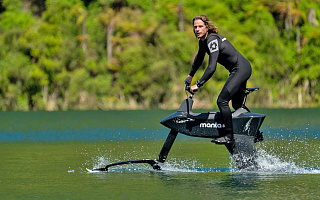Fuel-powered boards: brief review
We have talked a lot about electric surfboards and electric foils in our recent articles, now it's time to discuss petrol boards. Let's see what their pros and cons are, who they are suitable for and which boards and manufacturers you should pay attention to.
Although electric surfboards are becoming more and more popular and some people believe that these boards are the future, petrol surfboards also have something to answer for, they have advantages that electric surfboards do not have.
Advantages and pros
Now there are several manufacturers who make modern gasoline boards for different purposes - for beginners, for long races, for experienced riders. The most famous and significant manufacturer is of course the JETSURF from Czech Republic, and also we can mention here boards produced by the DLE (China), the Mako (UK).
JETSURF boards
The greatest variety of models is presented by the JETSURF company. We have already shared an article about the Adventure DFI Plus (the price is around € 17 280 for April 2023) - one of the most convenient boards for long rides or family trips. Beginners would feel really confident when riding this board or the Adventure DFI (from about from € 15 600) which is great for cruising and fun ride. For more experienced riders who want to do some stunts, sharp twists and jump the manufacturer suggests to get JETSURF Race DFI (from € 17 280) or Titanium DFI (ap. € 19 200), the latter is featured especially for those who want to compete - its top speed is 63 km/h!

DLE Jetboard
This is one of the most affordable boards on the market, priced at around € 6 800. DLE Engines is a Chinese company originally specializing in RC and airplane engines, and now they are producing simple, laconic and lightweight (18 kg) petrol boards. The board is rather powerful (equipped with a 8 kW two-stroke gasoline engine) and fast - its maximum speed is 55 km/h.

Mako Slingshot
According to the manufacturers, each board is “hand built by skilled technicians at a British-based factory”. The board is powered by a fuel-efficient Rotron XT100 engine producing 15 hp and the ride time is 40 minutes at full throttle. It is made of carbon fiber and it’s suitable for beginners and more experienced riders. The board is also pretty compact, so you can easily transport it in your car and then carry it to the water. The price is about € 12 600 for April 2023.

Although electric surfboards are becoming more and more popular and some people believe that these boards are the future, petrol surfboards also have something to answer for, they have advantages that electric surfboards do not have.
Advantages and pros
- Weight. Fuel-powered boards are really easy to carry around. They weigh around 20 kg (of course, depending on the model and brand) - for comparison, electric boards weigh an average of 34-51 kg.
- “Non-stop” riding. Petrol boards will give you up to 1 hour of pure non-stop riding pleasure. And if that's not enough for you, you just need to fill up the fuel tank - and you can carry on.
- Maneuverability. Such boards are truly agile on the water. As they are pretty light, it allows you to jump high, make sharp turns and even hit the race track if you want to.
- Transportation. You can easily travel with the fuel-powered board on a plane - just check it as an oversized luggage and then enjoy your flight.
- Loudness. Fuel-powered boards are significantly louder than the electric ones. Some models have a built-in silencer that greatly reduces the noise of the engine. But in general the sound of the two-stroke engine is pretty recognizable.
- Petrol boards require a bit more maintenance in comparison to electric boards.
- There are two-stroke engine limitations in certain places and water reservoirs.
Now there are several manufacturers who make modern gasoline boards for different purposes - for beginners, for long races, for experienced riders. The most famous and significant manufacturer is of course the JETSURF from Czech Republic, and also we can mention here boards produced by the DLE (China), the Mako (UK).
JETSURF boards
The greatest variety of models is presented by the JETSURF company. We have already shared an article about the Adventure DFI Plus (the price is around € 17 280 for April 2023) - one of the most convenient boards for long rides or family trips. Beginners would feel really confident when riding this board or the Adventure DFI (from about from € 15 600) which is great for cruising and fun ride. For more experienced riders who want to do some stunts, sharp twists and jump the manufacturer suggests to get JETSURF Race DFI (from € 17 280) or Titanium DFI (ap. € 19 200), the latter is featured especially for those who want to compete - its top speed is 63 km/h!
DLE Jetboard
This is one of the most affordable boards on the market, priced at around € 6 800. DLE Engines is a Chinese company originally specializing in RC and airplane engines, and now they are producing simple, laconic and lightweight (18 kg) petrol boards. The board is rather powerful (equipped with a 8 kW two-stroke gasoline engine) and fast - its maximum speed is 55 km/h.
Mako Slingshot
According to the manufacturers, each board is “hand built by skilled technicians at a British-based factory”. The board is powered by a fuel-efficient Rotron XT100 engine producing 15 hp and the ride time is 40 minutes at full throttle. It is made of carbon fiber and it’s suitable for beginners and more experienced riders. The board is also pretty compact, so you can easily transport it in your car and then carry it to the water. The price is about € 12 600 for April 2023.
Link copied






